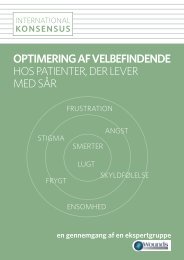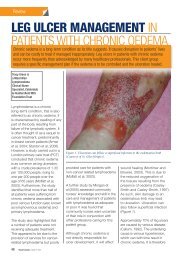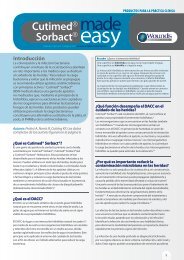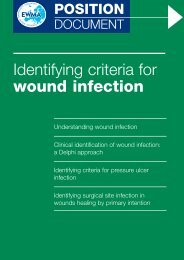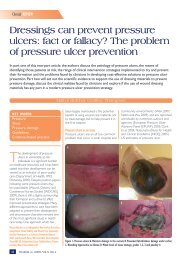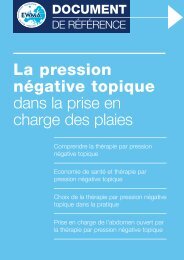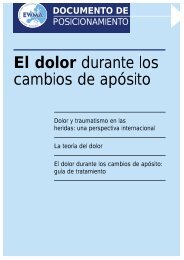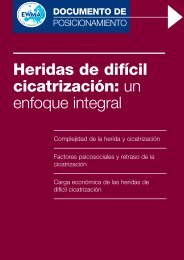VIEW PDF - Wounds UK
VIEW PDF - Wounds UK
VIEW PDF - Wounds UK
You also want an ePaper? Increase the reach of your titles
YUMPU automatically turns print PDFs into web optimized ePapers that Google loves.
Clinical RESEARCH/AUDITincreasing number and complexity ofpatients being managed by woundcare specialists today. In terms of theestablished hierarchy of evidencethat is widely referred to in theliterature (Barton, 2000; Greenhalgh,2001), randomised controlled trials(RCTs) are considered to be the‘gold standard’ method of determiningclinical efficacy and providing validand reliable information regarding thetrue effect of various interventions(Price, 1999; Greenhalgh, 2001).The issue that presents itself whentrying to combine what some wouldconsider proven conventional researchmethods to measure outcomes withcomplex patients is that these patientsdo not necessarily fit into the strictinclusion/exclusion criteria defined byRCTs. These criteria often appear tolead to the requirement for an almost‘perfect’ wound or ‘perfect’ patientthat in reality is difficult to find. Whenthis is combined with the evaluationof a complex, personal and subjectiveexperience like wound pain, it is evidentthat the interpretation of the results ofan RCT may not necessarily reflect thetrue effect of any given interventionas was previously thought. The resultsof an RCT also do not always readilypromote the translation of research intopractice and, in the case of patients withcomplex wounds, do not necessarilyalways achieve their aim of strictlycontrolling bias due to a potential lackof external validity.These issues highlight the need forother approaches to be consideredwhen evaluating new treatmentsor interventions on patient-centredoutcomes for patients with complexwounds, even if these approachesare not deemed to deliver the bestevidence in terms of the traditionalhierarchy. While case series are oftenconsidered to be relatively weakscientific evidence, they can be usefultools for recording interesting cases andexploring subjective experiences from apatient’s perspective, while incorporatingsome more objective measures or tools(Greenhalgh, 2001; Peat et al, 2002).They can also be useful at bridging thegap between theory and practice asthey are easy for non-academic cliniciansto understand (Greenhalgh, 2001). AsGreenhalgh (2001) stated, evaluatingthe potential contribution of particularstudies to an overall evidence baseneeds to go beyond placing it into afixed hierarchy — thus, every study hasthe potential to provide evidence thatcan be combined with experience toguide clinical practice, and we should notnecessarily only consider changing ourpractice based on the statistical outcomeof certain methods.In view of this, and withacknowledgement of the complexityof the population of patients routinelyseen in clinics, an audit was conductedof the effect of Actiform Cool onwound-related pain, the results of whichwill be illustrated by descriptions ofcase studies. The use of an audit withassociated case series was considereda more appropriate approach in thiscase as it provided a more accuraterepresentation of the use of ActiformCool on patients with the types ofpainful complex wounds and associatedco-morbidities that are often met inthe clinical setting. This method alsoenabled patient views on a personal andsubjective experience to be obtained.MethodThe audit sample population was madeup of patients attending both complexwound clinics and community leg ulcerclinics over a six-month period. Anypatient with a painful wound suitable fortreatment with a sheet hydrogel dressingand who was willing to participate wasincluded. Demographic details andmedical history and current medicationswere collected. A full wound assessmentwas performed using the standardisedcriteria set out in the normal clinicwound assessment chart. This includedassessment of the wound bed, woundedge, surrounding skin, exudate levels andpresence of odour. Photographs and areameasurements were taken to monitorchanges in wound size and appearance assecondary outcome measures.The primary outcome measurewas change in wound-related pain andwas assessed using the Short-FormMcGill Pain Questionnaire (SF-MPQ)(Melzack, 1987). This assessment toolwas chosen as it is able to capture thenature as well as the intensity of painexperienced. The SF-MPQ is a generictool that has been shown to be bothvalid and reliable in several differentpatient populations (Seymour, 1982;Helme et al, 1989; Dudgeon et al, 1993;McDonald and Weiskopf, 2001), andhas been demonstrated to be easy foruse by patients (Melzack, 1987; Helmeet al, 1989). Although it has not beendirectly validated for use in patientswith wounds, it has been widely usedin studies within the wound care realm(Cullum and Roe, 1995; Noonan andBurge, 1998; Walters et al, 1999). The SF-MPQ incorporates 14 pain descriptorsassessing both sensory and affective paindimensions scored on a 4-point scalefrom 0 (None) to 3 (Severe). A 100mmVisual Analogue Scale (VAS) is includedto measure overall intensity. The SF-MPQ was administered before the initialapplication of Actiform Cool and oncompletion of the audit.Patients were also asked to reporton any changes in their experience ofpain and to comment if the pain hadany effect on their activities of dailyliving, such as sleep and mobility. Thiswas to again to elicit the views of thepatient’s experience and any effect onoutcomes that were important to themand impacted on their quality of life.Any changes to dosage and frequencyof analgesia used to control wound painwere also recorded.Actiform Cool was applied inconjunction with any previously usedtreatment, such as compressionbandaging. They were able to increaseor decrease their analgesia as requiredas the dressing was to be used as anadjunct to standard methods of paincontrol. Patients remained on the auditfor up to five weeks depending on theprogress of the wound, effect on painlevels and personal preference. Patientswere audited using Actiform Cool forup to four weeks. The final assessmentwas performed on the next routine clinicappointment, unless contactedby the patient with any concerns.Interim dressing changes wereperformed either by the patient orcommunity nursing team.<strong>Wounds</strong> <strong>UK</strong>, 2008, Vol 4, No 323




